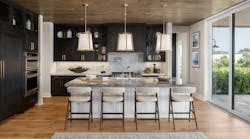Small, infill multifamily projects like this one exemplify the tenets of Lean Urbanism, a growing movement that was born out of New Urbanism.
Photo: Anderson|Kim Architeture & Design
Since the seminal New Urbanist community of Seaside opened 35 years ago, more “urbanisms” have come to light, including Lean Urbanism, Tactical Urbanism, and Landscape Urbanism. Lean Urbanism is an initiative of Duany Plater-Zyberk (DPZ) & Co., in Miami, the architecture firm that designed Seaside, Kentlands, and other influential New Urbanist projects.
DPZ partner Andres Duany wrote a paper last June on the subject of Lean Urbanism for greenfield sites, using Seaside as a case study. When I interviewed Duany recently, he said, “Seaside is, paradoxically, the least sophisticated of the New Urbanist communities and the most sophisticated. It has been transcended technically [by other communities] over the years, but it is incredibly avant-garde in terms of its environmental performance.”
What makes Seaside a lean greenfield development? Neither farmland nor pristine wilderness was eradicated; instead, the town was built on a relatively fallow site that had been logged a few years prior to development. The site’s natural dunes were preserved. Nearly all the streets run perpendicular to the shoreline to channel prevailing breezes. Vernacular architecture utilizes porches and roof overhangs so that windows can remain open even when it rains. Rooms are cross-ventilated whenever possible. And the houses are raised off the ground, which provides a cooling effect.
“The piers were dug by hand so we didn’t have to knock out all the little shrubs which, it turns out, were native oak,” Duany says. Thirty-five years later, those little shrubs have grown into trees that provide a shady canopy across the site.
In 1980, the use of brick on sand—with interstices separating each brick to create a permeable pavement—was cutting edge; it allowed rainwater to percolate into the ground instead of running off. Galvanized metal roofs are a durable, cost-effective alternative to less wind-resistant asphalt shingles and have high reflective abilities that aid in cooling the buildings.
All of these measures were implemented before LEED ever existed. But while Seaside is a great model for Lean Urbanism in greenfields, Duany and other advocates want builders and developers to shift their focus to small infill sites.
“It’s all about enabling the small developer,” Duany says. “Lots of people can make a living building six to 10 houses a year, and the world will be better for it.”
John Anderson, principal of Anderson|Kim Architecture & Design, in Chico, Calif., says, “We need more entry-level infill structures that are easier to get [permitted].” Anderson, who once developed large-scale projects in Southern California, is putting his money where his mouth is, building smaller, more economical projects in established neighborhoods. At a time when appraisals and [mortgage] qualifications are tough to obtain, Anderson is building rental apartments—not 150 units at a time, but small projects that over time his company can manage efficiently. (One of his recent successes is a 22-unit apartment project in a built-out TND in Chico.)
“Creating a backlog of modest multifamily projects that can be built without the pressure of individual house closings can provide even and predictable workflow for a builder’s trade partners, which can help the builder reduce the impact of shortages in skilled trades,” Anderson says.
My upcoming article on New Urbanism, which will appear in the July issue of Professional Builder, touches on some of these issues. But I’m planning to write more about Lean Urbanism in future issues, so stay tuned.
About the Author

Susan Bady
Susan Bady has been writing about the housing industry for 30 years. She is senior editor of Professional Builder and Custom Builder magazines, and produces the Design Innovation e-newsletter. Bady has also written for such consumer magazines as Cabin Life and Better Homes and Gardens’ Home Plan Ideas.


